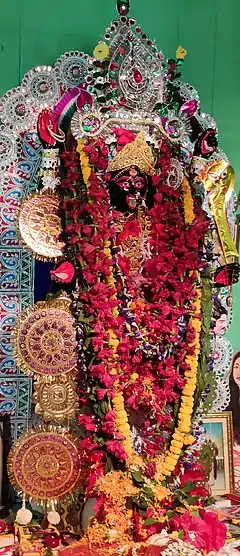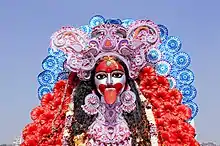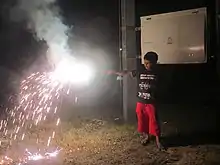Kali Puja
Kali Puja (ISO: Kālī Pūjā), also known as Shyama Puja or Mahanisha Puja,[1] is a festival originating from the Indian subcontinent, dedicated to the Hindu goddess Kali. It is celebrated on the new moon day (Dipannita Amavasya) of the Hindu calendar month of Ashwayuja (according to the amanta tradition) or Kartika (according to the purnimanta tradition). The festival is especially popular in the region of West Bengal, and other places like Mithila and Anga of Bihar Odisha, Assam, and Tripura, as well as the town of Titwala in Maharashtra, along with the neighbouring country of Bangladesh.
| Kali Puja | |
|---|---|
 Goddess Kali | |
| Observed by | Hindus |
| Type | Hindu |
| Celebrations | Fireworks |
| Observances | Puja, prasadam |
| Date | Ashwayuja 30 (Amanta) Karthika 15 (Purnimanta) |
| 2023 date | 12 November |
| 2024 date | 31 October |
| Frequency | Annual |
History
The festival of Kali Puja is not an ancient one. Kali Puja was practically unknown before the 16th century; famous sage Krishnananda Agamavagisha first initiated Kali Puja. A late 17th-century devotional text, Kalika mangalkavya, also mentions an annual festival dedicated to Kali.[2] In Bengal during the 18th century, King (Raja) Krishnachandra of Nabadwip also made this puja wide spread.[3] Kali Puja gained popularity in the 19th century, when kali saint Shri Ramkrishna became popular among the Bengalis ; wealthy landowners began patronizing the festival on a grand scale.[4] Along with Durga Puja, Kali Puja is the biggest festival in Tamluk, Barasat,[5] Naihati, Barrackpore, Dhupguri, Dinhata, Tapshitala. It is also famous in Bhagalpur of Bihar.
Worship

During Kali Puja (like Durga Puja) worshippers honour the goddess Kali in their homes in the form of clay sculptures and in pandals (temporary shrines or open pavilions). She is worshipped at night with tantric rites and mantras. She is prescribed offerings of red hibiscus flowers, sweets, rice and lentils. It is prescribed that a worshipper should meditate throughout the night until dawn.[6] Homes and pandals may also practice rites in the Brahmanical (mainstream Hindu-style, non-Tantric) tradition with ritual dressing of Kali in her form as Adya Shakti Kali and no animals are sacrificed. She is offered food and sweets made of rice, lentils, and fruits.[7] However, in Tantric tradition, animals are ritually sacrificed on Kali Puja day and offered to the goddess.[3] A celebration of Kali Puja in Kolkata is held in a large cremation ground[8] (Kali is believed to dwell in ceremation grounds).[9] Barasat, Barrackpore, Naihati and Madhyamgram region of North 24 Parganas, In North Bengal: Dhupguri, Dinhata, Coochbehar is well known for their majestic pandals, lightings and Idols. Durga Puja of Kolkata is often said synonymously with Kali Puja of Barasat. The region experiences Lacs of footfalls during the days of the festival. People from different regions gather to witness the majestic Pandals.
The pandals also house images of Kali's consort, Shiva, two famous Bengali Kali devotees named Ramakrishna and Bamakhepa, along with scenes from mythology of Kali and her various forms, including images of the Mahavidyas, sometimes considered as the "ten Kalis." The Mahavidyas is a group of ten Tantric goddesses headed by Kali.[10] People visit these pandals throughout the night. Kali Puja is also the time for magic shows, theater, and fireworks.[7] Recent custom has incorporated wine consumption.[11]
In the Kalighat Temple in Kolkata, Kali is worshipped as Lakshmi on this day. The temple is visited by thousands of devotees who give offerings to the goddess.[3][8] Another famous temple dedicated to Kali in Kolkata is Dakshineswar Kali Temple, where Sri Rāmakrishna performed rites.[lower-alpha 1] Khepa kali tala (Khepi Maa) in Katwa.
Other celebrations



Although the widely popular annual Kali Puja celebration, also known as the Dipanwita Kali Puja, is celebrated on the new moon day of the month of Kartika, Kali is also worshipped in other new moon days too. Three other major Kali Puja observations are Ratanti Kali Puja, Phalaharini Kali Puja and Kaushiki Kali Puja. Kaushiki Kali Puja is associated with Goddess Tara of Tarapith, while Ratanti puja is celebrated on Magha Krishna Chaturdashi and Phalaharini puja is celebrated on Jyeshta Amavashya of Bengali calendar. The Phalaharini Kali Puja is especially important in the life of the saint Ramakrishna and his wife Sarada Devi, since on this day in 1872, Ramakrishna worshipped Sarada Devi as the goddess Shodashi.[12] In many Bengali and Assamese households, Kali is worshipped daily.[13]
Notes
- See Harding 1998, pp. 125–6 for a detailed account of the rituals in Dakshineshwar.
References
Citations
- "Diwali". Archived from the original on 30 November 2015. Retrieved 30 October 2012.
- McDermott 2001, p. 373.
- McDermott & Kripal 2003, p. 72
- McDermott 2001, p. 173.
- McDaniel 2004, p. 223.
- McDaniel 2004, p. 234.
- McDaniel 2004, pp. 249–50, 54.
- Fuller 2004, p. 86.
- Crooke, William (1909). "Death; Death Rites; Methods of Disposal of the Dead among the Dravidian and Other Non-Aryan Tribes of India". Anthropos. 4 (2): 457–476. JSTOR 40442412.
- Kinsley 1997, p. 18.
- Harding 1998, p. 134.
- Gambhirananda 1955, pp. 48–51.
- Banerjee 1991, p. 114.
Works cited
- Banerjee, Suresh Chandra (1991). Shaktiranga Bangabhumi [Bengal, The Abode of Shaktism] (in Bengali) (1st ed.). Kolkata: Ananda Publishers Pvt Ltd. ISBN 81-7215-022-9.
- Fuller, Christopher John (2004). The Camphor Flame: Popular Hinduism and Society in India. Princeton University Press. ISBN 978-0691120485.
- Gambhirananda, Swami (1955). Holy Mother Shri Sarada Devi (1st ed.). Madras: Shri Ramakrishna Ashrama, Madras.
- Harding, Elizabeth U. (1998). Kali: The Black Goddess of Dakshineswar. India: Motilal Banarsidass Publishers. ISBN 978-8120814509.
- Kinsley, David R. (1997). Tantric Visions of the Divine Feminine: The Ten Mahavidyas. University of California Press. ISBN 978-0520917729.
- McDaniel, June (2004). Offering Flowers, Feeding Skulls: Popular Goddess Worship in West Bengal. Oxford University Press. ISBN 978-0195347135.
- McDermott, Rachel Fell (2001). Mother of My Heart, Daughter of My Dreams: Kali and Uma in the Devotional Poetry of Bengal. Oxford University Press. ISBN 978-0198030713.
- McDermott, Rachel Fell; Kripal, Jeffrey John (2003). Encountering Kali: In the Margins, at the Center, in the West. University of California Press. ISBN 978-0520232402.
Further reading
- McDermott, Rachel Fell (2011). Revelry, Rivalry, and Longing for the Goddesses of Bengal: The Fortunes of Hindu Festivals. New York: Columbia University Press. ISBN 978-0231129190.
- Saraswati, Swami Satyananda, tr. (1999). Kali Puja. 1st World Publishing. ISBN 1-887472-64-9.
{{cite book}}: CS1 maint: multiple names: authors list (link)


